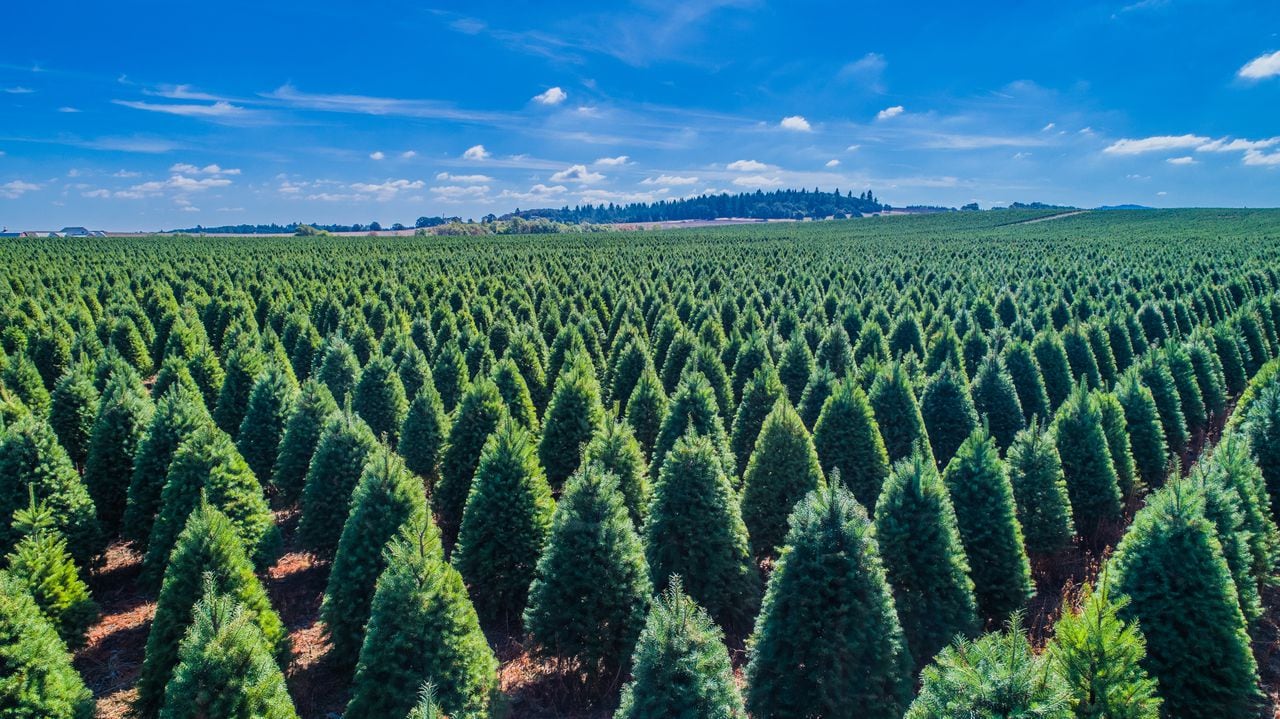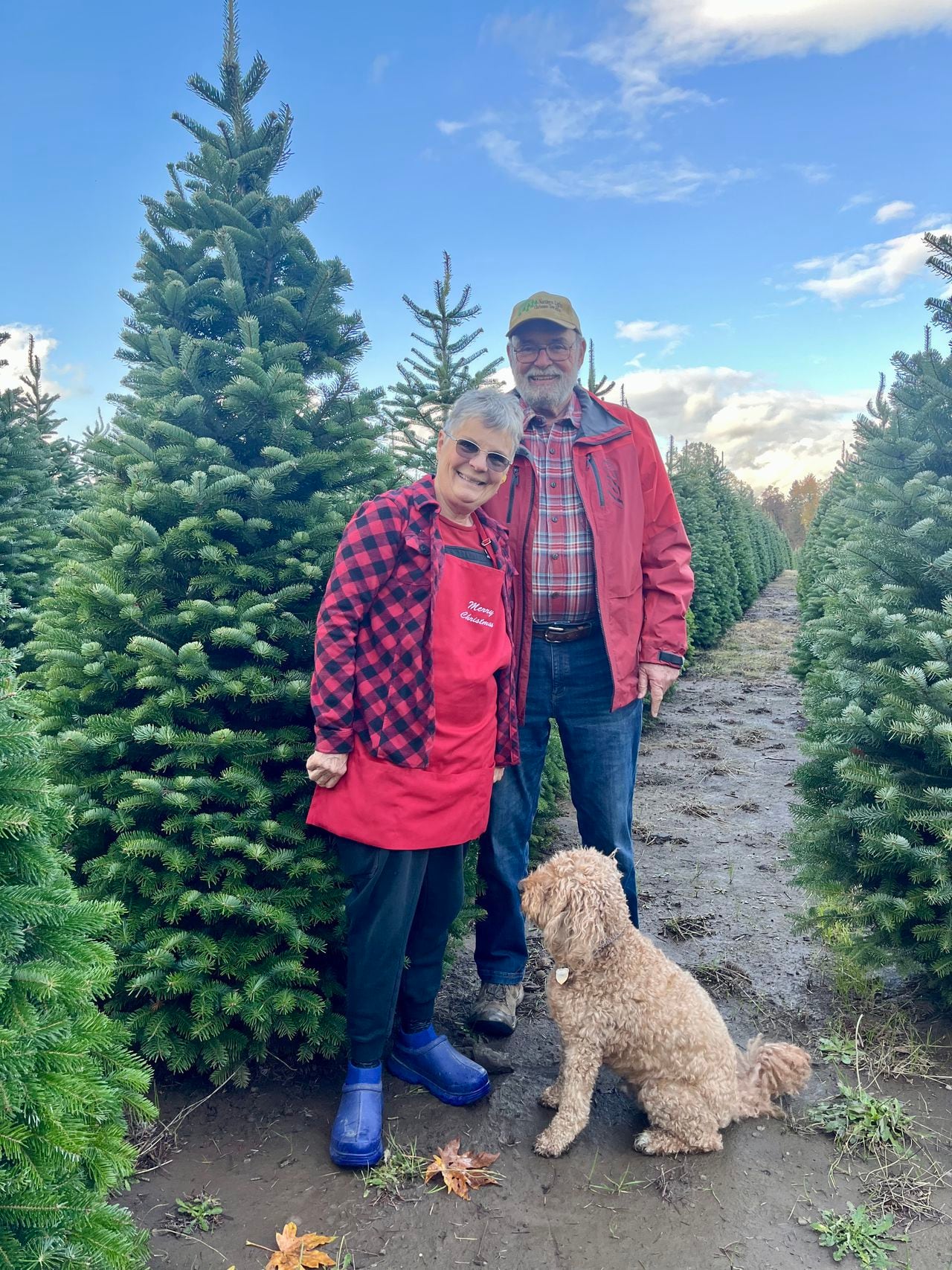Bob Schutte is sitting on the porch of his log home along the Willamette River, his wife, Lynn, by his side and a Santa Claus twinkle in his eyes. “This is way beyond our original dreams,” he said, nodding toward the couple’s 162-acre Northern Lights Christmas Tree Farm in Pleasant Hill, south of Eugene.
In the distance, a green tractor rolls through tidy rows, pulling a trailer of fresh cut trees to be decorated and displayed in the farm’s gift store. Thousands of holiday shoppers will stream through the farm, from Nov. 24, the Friday after Thanksgiving, until Christmas Eve, Dec. 24, in search of a real tree and memories.
One shopper will be Lisa Fjordbeck, who lives nine miles away in Springfield. She said picking a tree at the Northern Lights Christmas Tree Farm has been a family tradition for about 20 years. Riding on hay bales in a wagon pulled by a vintage red farm tractor on the way to the tree fields is “like an experience from a past era or a holiday movie,” she said. “Everybody is happy.”
Genuinely making tree farms here feel old-fashioned: Although Oregon has long been the top producer of Christmas trees in the nation, most of the state’s growers are family-run businesses, often with the second and third generations now in charge.
HERE IS OREGON: HereisOregon.com | Instagram | YouTube | Facebook | Twitter | TikTok
In 30 years, the state transformed from selling wild trees thinned in forests to, by the 1970s, having farms producing fragrant Douglas fir trees with soft dark green or blue green needles that became the staple of Christmas tree markets throughout the United States and around the world.
The Schuttes sell their trees directly to customers while other growers like Tom Norby of the 50-acre Trout Creek Tree Farm near Corbett work strictly with wholesalers, including retailers in Shanghai and Dubai.
The largest of the state’s Christmas tree producers, Holiday Tree Farms based in Corvallis, ships the iconic emblem of the holiday, a real cone-shaped tree — sometimes close to as many as a million a year — primarily to California and as far away as the Philippines.
Unlike past years, Norby, who also heads the Pacific Northwest Christmas Tree Association and the Oregon Christmas Tree Growers, said there will be good availability of quality trees this year and pricing should be similar to last year.
Jeff Larcom of Holiday Tree Farms agrees. He’s the third generation of his family to lead the Christmas trees business founded in 1955. Today, the company manages about 9,000 acres of land and about 8 million, labor-intensive Christmas trees as they take years to mature.
“Each year we evaluate the crop that’s available for harvest and only tag and cut the best Christmas trees for our customers,” said Larcom, whose workforce rises to 700 during harvest season. “The trees are grown in fields like other agricultural products and after harvest, the stumps are ground down back into the soil and we fallow the land with a cover crop to ensure the longterm viability of the land.”
During the first year of the pandemic in 2020, when even outdoor public gatherings were restricted to reduce the spread of the coronavirus, U-cut farms offered limited access, if they opened at all. That year, Oregon Christmas tree growers cut and sold 3.44 million trees, a decrease of 27% from 2015, according to the U.S. Department of Agriculture (USDA), which conducts a study every five years.
Still, Oregon’s Christmas tree industry’s market value in 2020 was $110 million, the 14th most valuable agricultural commodity in the state. That year, producers planted 6.15 million seedlings, according to the USDA. Other big-producing states, far behind Oregon, in order, are North Carolina, Michigan, Pennsylvania and Washington.
Before the pandemic, Christmas tree farmers endured years of drought and hot summers that killed seedlings and young trees, especially noble firs.
Forestry experts like Chal Landgren, a Christmas tree specialist who retired after 40 years at Oregon State University, researched ways to harden existing tree species and helped introduce Turkish, Trojan and Nordmann firs from the mountains of Turkey and the Republic of Georgia.
Many Oregon growers now offer Nordmann firs, which, like the noble fir, can keep its needles for 30 days after being cut if always hydrated, said Norby.
The biggest challenge to Christmas tree growers and the environment are fake trees. Eight out of 10 Christmas trees seen in the U.S. are artificial, TIBCO Software Inc. data scientists found.
Environmental organization The Nature Conservancy advocates for real trees over petrochemical plastic ones that require intensive carbon emissions to produce. Buying real trees supports local tree farms, which pay wages in the community, and maintains healthy forested land, say experts. After the holidays, real Christmas trees, stripped of nonorganic materials, can be used as wood chips, compost and wildlife habitats for birds and fish.
The U.S. Forest Service encourages people to help thin densely populated stands by buying a permit at Recreation.gov and cutting a small-diameter Christmas tree in designated areas of some national forests.
Bob Schutte of Northern Lights Christmas Tree Farm understands the appeal of paying $5 for a permit to harvest a wild tree. “Some folks want the natural look and they have a wonderful adventure going to cut their own tree,” he said, then joked, “After they get soaking wet, they come and buy a tree here.”
The Schuttes, who are both 79, are energized by the holidays. They had a corn maze and a pumpkin patch open to the public for the entire month of October. Then they turned their attention to late November through December events. Ornaments representing different cultural traditions are for sale along with fresh garlands and gnomes.
Each of the 35 trees displayed in the gift shop has a different theme, from nativity and nutcracker to books and films like “The Nightmare Before Christmas,” and anything pickle ball related, said Lynn. “I don’t know if this is a commentary on society but our Beer/Wine tree does extremely well,” she said. “I expect these trends to continue.”
The farm’s rustic wood buildings are dressed in twinkling lights and, inside the wreath shed, people customize a circle of greenery by picking out ribbon and adornments. With a view of the historic hay barn, there’s an espresso and hot chocolate bar and a bonfire to toast marshmallows from a s’more kit for sale.
The Schuttes met 63 years ago in a California high school chemistry class. He has a mechanical engineering degree and she is a retired elementary schoolteacher. They bought the farmland in 1986 and had their first tree harvest in 1994, making this their 30th harvest.
Noble, Nordmann and Turkish fir trees, in varying stages of their years-long growth cycle, occupy half of their farm. They also raise grass-fed cattle, grazing on pasture along the Middle Fork of the Willamette River.
The misconception about the Christmas tree business: “People think you plant a seedling, let it grow and then sell it,” said Bob as Lynn chuckled.
The reality: “There’s ground prep, and after planting, there’s fertilizing, irrigation, weed control, mowing, shearing, removing the bottom branches and more” for about eight years, per tree, he said. “Lynn and I are fortunate in that we have positive attitudes, we genuinely enjoy our customers’ company and what we are doing is a good fit for who we are.”
— Janet Eastman | 503-294-4072
jeastman@oregonian.com | @janeteastman

